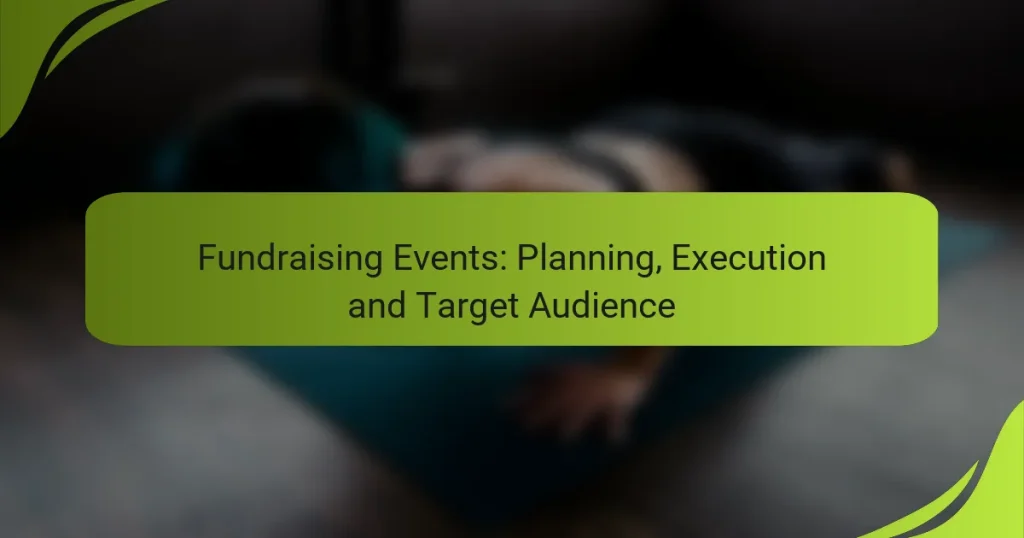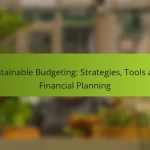Planning and executing successful fundraising events involves a strategic approach that encompasses clear objectives, a well-defined target audience, and meticulous attention to detail. By engaging community members, corporate sponsors, and nonprofit supporters, organizers can tailor their events to enhance participation and maximize donations. Effective logistics, volunteer engagement, and social media outreach are essential components that contribute to the overall success of these initiatives.

How to plan successful fundraising events in major US cities
Planning successful fundraising events in major US cities requires careful consideration of objectives, audience, venue, budget, and timeline. By focusing on these key elements, organizers can create engaging and effective events that maximize fundraising potential.
Define clear objectives
Establishing clear objectives is essential for any fundraising event. Objectives should be specific, measurable, achievable, relevant, and time-bound (SMART). For example, aim to raise a specific amount of money or increase awareness for a cause within a set timeframe.
Consider the overall mission of your organization and how the event aligns with it. This will help in communicating the purpose to potential attendees and sponsors, making it easier to rally support.
Identify target audience
Understanding your target audience is crucial for tailoring the event to their interests and preferences. Consider demographics such as age, income level, and location to ensure the event resonates with attendees.
Engage with your audience through surveys or social media to gather insights on what types of events they enjoy. This information can guide decisions on themes, activities, and promotional strategies.
Select appropriate venue
The venue plays a significant role in the success of a fundraising event. Choose a location that is accessible and appealing to your target audience. Consider factors such as capacity, amenities, and ambiance.
In major US cities, venues can vary widely in cost. Research options ranging from community centers to upscale hotels, and ensure the venue aligns with your budget and objectives.
Set a budget
Creating a realistic budget is essential for managing expenses and maximizing fundraising efforts. Include all potential costs, such as venue rental, catering, entertainment, and marketing materials.
As a rule of thumb, aim to keep expenses below 30% of your fundraising goal to ensure a healthy return on investment. Regularly review the budget as planning progresses to stay on track.
Create a timeline
A detailed timeline helps keep the planning process organized and ensures all tasks are completed on schedule. Start by outlining major milestones, such as securing the venue, launching promotions, and finalizing logistics.
Break down each milestone into smaller tasks with deadlines. A timeline can help identify potential bottlenecks and allow for adjustments as needed, ensuring a smooth execution of the event.

What are the best practices for executing fundraising events?
Executing successful fundraising events requires careful planning and attention to detail. Key practices include engaging volunteers, leveraging social media, implementing effective ticketing strategies, and ensuring smooth logistics.
Engage volunteers effectively
Volunteers are essential for the success of fundraising events. To engage them effectively, provide clear roles and responsibilities, and ensure they understand the event’s goals. Regular communication and training sessions can help keep volunteers motivated and informed.
Consider creating a volunteer handbook that outlines expectations, schedules, and contact information. Recognizing and rewarding volunteers after the event can also foster loyalty and encourage future participation.
Utilize social media for promotion
Social media is a powerful tool for promoting fundraising events. Use platforms like Facebook, Instagram, and Twitter to share event details, engage with potential attendees, and create buzz. Regular updates and engaging content, such as videos or testimonials, can enhance visibility.
Consider using targeted ads to reach specific demographics or local communities. Encourage attendees to share the event on their own social media, which can exponentially increase reach and engagement.
Implement ticketing strategies
Effective ticketing strategies can significantly impact fundraising outcomes. Offer various ticket types, such as early bird discounts, VIP packages, or group rates, to attract a wider audience. Use online platforms for easy purchasing and tracking of sales.
Consider setting a goal for ticket sales and regularly updating your team on progress. This can create a sense of urgency and motivate both volunteers and attendees to promote the event further.
Ensure smooth logistics
Logistics play a crucial role in the success of fundraising events. Create a detailed plan that covers venue setup, equipment needs, catering, and transportation. Conduct a walkthrough of the venue before the event to identify potential issues.
Establish a timeline for each aspect of the event, from setup to breakdown. Assign specific team members to oversee different areas, ensuring accountability and efficiency during the event.

Who is the target audience for fundraising events?
The target audience for fundraising events typically includes local community members, corporate sponsors, and nonprofit supporters. Understanding these groups helps tailor the event’s messaging and outreach strategies to maximize participation and donations.
Local community members
Local community members are often the backbone of fundraising events. They are usually the first to support initiatives that directly impact their neighborhoods, making them crucial for grassroots fundraising efforts.
To engage this audience, consider hosting events that resonate with local interests, such as community fairs, charity runs, or benefit dinners. Offering family-friendly activities can also enhance participation and foster a sense of community.
Corporate sponsors
Corporate sponsors provide significant financial support and resources for fundraising events. They often seek visibility and positive brand association through their involvement, making it essential to align your event with their corporate social responsibility goals.
When approaching potential sponsors, clearly outline the benefits of partnership, such as brand exposure, networking opportunities, and community goodwill. Tailor sponsorship packages to include various levels of investment, allowing businesses of all sizes to participate.
Nonprofit supporters
Nonprofit supporters, including individual donors and philanthropic organizations, are vital for sustaining fundraising efforts. They are typically motivated by a passion for the cause and a desire to make a difference.
To attract and retain these supporters, maintain transparent communication about how funds will be used and the impact of their contributions. Regular updates, success stories, and acknowledgment of their support can strengthen these relationships and encourage ongoing engagement.

What criteria should be used to select fundraising event themes?
Selecting fundraising event themes requires careful consideration of alignment with your organization’s mission, audience interests, and seasonal relevance. These criteria ensure that the event resonates with participants and maximizes engagement and donations.
Align with organizational mission
The theme of your fundraising event should reflect your organization’s core values and mission. This alignment helps reinforce your brand identity and builds trust with your supporters. For instance, if your organization focuses on environmental conservation, a theme centered around sustainability can resonate strongly with your audience.
When selecting a theme, consider how it can showcase your mission through activities, messaging, and visuals. This approach not only attracts donors but also encourages them to feel a deeper connection to your cause.
Consider audience interests
Understanding your target audience’s interests is crucial for selecting an engaging fundraising event theme. Conduct surveys or analyze past event data to identify what themes have previously attracted participants. For example, if your audience enjoys outdoor activities, a themed charity run or hike may be appealing.
Incorporating popular trends or local culture can also enhance interest. Tailoring the theme to reflect the preferences of your audience increases the likelihood of participation and donations.
Evaluate seasonal relevance
Seasonal relevance can significantly impact the success of your fundraising event. Consider holidays, weather conditions, and local events when selecting a theme. For example, a winter gala may be more appealing during the holiday season, while a summer picnic could attract more attendees in warmer months.
Aligning your theme with seasonal factors not only enhances the event experience but also allows for creative marketing opportunities. Use seasonal elements in your promotions to draw attention and encourage attendance, ensuring your event stands out in a crowded calendar.

What are the costs associated with fundraising events?
The costs associated with fundraising events can vary widely based on the event’s scale, location, and specific needs. Key expenses typically include venue rental fees, marketing and promotion costs, and staffing and volunteer expenses, each of which requires careful budgeting to ensure a successful outcome.
Venue rental fees
Venue rental fees are often one of the largest expenses for fundraising events. Depending on the location and type of venue, costs can range from a few hundred to several thousand dollars. It’s essential to consider factors such as capacity, amenities, and accessibility when selecting a venue.
When budgeting for venue costs, be aware of additional fees that may apply, such as security deposits, cleaning fees, and insurance. Negotiating with venue owners can sometimes lead to discounts or package deals that include catering or equipment rental.
Marketing and promotion costs
Marketing and promotion costs are crucial for attracting attendees and donors to your fundraising event. These expenses can include digital advertising, print materials, social media promotions, and public relations efforts. A reasonable budget for marketing can range from 10% to 20% of your total event budget.
To maximize your marketing impact, consider using a mix of channels tailored to your target audience. Utilize social media platforms, email newsletters, and community partnerships to spread the word effectively while keeping costs manageable.
Staffing and volunteer expenses
Staffing and volunteer expenses encompass costs related to hiring temporary staff, training volunteers, and providing necessary resources. While volunteers can significantly reduce costs, it’s important to budget for any training materials, meals, or incentives you may want to offer.
When planning for staffing, consider the size of your event and the roles needed, such as event coordinators, ticket sellers, and on-site support. A well-structured plan can help ensure that you have adequate coverage without overspending on labor costs.

How to measure the success of fundraising events?
Measuring the success of fundraising events involves evaluating various metrics such as funds raised, participant engagement, and overall impact. Key indicators can include the total amount collected, the number of attendees, and feedback from participants.
Key Performance Indicators (KPIs)
Key Performance Indicators (KPIs) are essential for assessing the effectiveness of fundraising events. Common KPIs include total funds raised, donor retention rates, and the cost per dollar raised. Establishing clear KPIs before the event allows for focused evaluation afterward.
For example, if an event raises $10,000 with expenses of $2,000, the cost per dollar raised is $0.20. This metric helps organizations understand their fundraising efficiency.
Participant Feedback
Gathering participant feedback is crucial for understanding the event’s impact and areas for improvement. Surveys can be distributed post-event to collect insights on attendee satisfaction, engagement levels, and suggestions for future events.
Consider using a mix of quantitative questions (e.g., rating satisfaction on a scale of 1-10) and qualitative questions (e.g., open-ended feedback) to gain comprehensive insights.
Comparative Analysis
Conducting a comparative analysis with previous events can provide context for the current event’s performance. Review metrics from past events to identify trends, such as increasing or decreasing attendance and funds raised.
For instance, if last year’s event raised $8,000 with 100 attendees and this year’s raised $10,000 with 120 attendees, it indicates growth in both funds and participation.
Post-Event Reporting
Creating a post-event report is vital for documenting the outcomes and insights gained. This report should include a summary of KPIs, participant feedback, and lessons learned. Sharing this report with stakeholders can enhance transparency and foster future support.
Include visuals such as charts or graphs to illustrate key data points, making the report more engaging and easier to digest.


